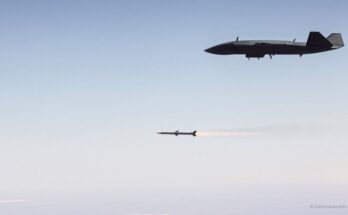
On April 30, the U.S. Navy announced that the Fincantieri bid for the FFG(X) program had won the competition, and it placed a $795 million order for the lead ship of the class. The detail design and construction contract covers one ship in the current Fiscal Year 2020 and options for up to a total of ten ships, with a total value of $5.58 billion if all options are exercised. By accepting a foreign design for a major surface combatant, the Navy has challenged almost two centuries of American naval tradition.
The FFG(X) competition was launched in 2017 when experience with the littoral combat ships (LCS) showed that those ships were too small, under-armed, and lacking in endurance to perform the duties they had been assigned. The ships also proved to be unreliable and to suffer continuous problems with their machinery – issues that were associated with their small size, since their machinery spaces were cramped, making proper routine maintenance difficult. These concerns all stemmed back to a decision made early in the LCS program: the adoption of a maximum speed of 45 knots or greater. No viable rationale for this very high speed has ever been presented, yet its malign effects are at the root of the problems that afflicted the LCS class.
This is not to say the two LCS classes were bad ships; in fact, their designers did a good job of meeting the specifications as well as they did. The problem was that in doing so, they were forced to accept compromises that, in the context of U.S. Navy operations, limited the value of the ships. Accordingly, construction of the two types of littoral combat ships has been curtailed, with at least four of the ships being relegated to an early decommissioning.
To prevent this from happening again, the U.S. Navy established an FFG Requirements Evaluation Team (FFG-RET) that included members of the fleet operations community, naval design experts, the budget community, fleet representatives, technology specialists, shipbuilders, and others in the industry. The FFG-RET was tasked with calculating the proper balance between capability and cost. The members of the FFG-RET were mindful of the LCS lesson that any given requirement had to be balanced against the overall cost of that demand when applied to that ship as a whole. This cost was measured in both financial and operational terms. An early casualty of this process was the notorious demand for a 45-knot maximum speed. The new FFG(X) would have the 28 – 30 knot speed normal for ships of this type.
In fact, innovation was explicitly discouraged when laying down the basic principles for FFG(X). The new class was required to be available off-the-shelf with proven experience at sea. The ships were to rely heavily on government-furnished equipment, including existing systems already at sea on other surface combatants in the fleet. These systems include an Enterprise Air Surveillance Radar (EASR), the Mk 41 Vertical Launch System, and the 5-inch Mk 45 gun. This provision both reduced costs and eased maintenance, training, and support requirements.
Finally, five proposals were accepted for further study. Two were modified versions of the LCS-1 Freedom and LCS-2 Independence classes that were enlarged to correct the design issues with the earlier version and add the required new equipment. One was proposed by Huntington Ingalls Industries as a development of its Coastguard cutter design. The remaining two were the Navantia F-100 class and Fincantieri’s FREMM. The last two were significantly larger than the other contestants, and their inclusion represented an explicit rejection of the concepts that had lain behind the LCS program.
As the design evaluation proceeded, the modified LCS-1 design was withdrawn by its sponsor, Lockheed Martin, on the basis that the original design lacked the margins needed to meet the new specifications. Reportedly, the Navantia design suffered from the sinking of the Norwegian frigate Helge Ingstad after a collision with an oil tanker that the Navy is reported to believe showed deficiencies in the damage resistance of the design. The Huntington Ingalls design is hard to evaluate since the company played details of its bid close to its chest. However, it may simply be that its Coastguard base gave the design the wrong set of characteristics for the Navy’s requirements.
Thus, the choice became either the proposal based on LCS-2 or FREMM. FREMM was a proven and successful design with multiple ships already in service with the French and Italian navies. LCS-2 featured a very large and capable flight deck that fitted well with the helicopter operations requirements, but it suffered from the shadow of the earlier LCS program. One naval officer, speaking off-the-record, suggested that the littoral combat ships had simply “lost the confidence of the fleet.”
As the last ship floating, the FREMM design was selected. A late effort was made to introduce the British Type 26 frigate on the back of its sales to Australia and Canada, but the proposal fell foul of the “already in service” requirement.
The U.S. Navy has announced that the detail design phase will begin immediately and that construction will begin no later than April 2022. The first ship of the class will be delivered by 2026 and reach initial operational capability by 2030. The lead ship will cost $1.281 billion, with $795 million of that covering the shipbuilder’s detail design and construction costs and the rest covering the GFE, including the combat systems, radar, launchers, command and control systems, decoys, and more. The remaining ships in the first flight of ten are scheduled to cost around $781 million each. Once the final member of this first order of 10 frigates is funded, probably in FY25, the Navy may elect to award the second flight of ten to Fincantieri, or it could choose to bring in a second yard to build the same ship, thus increasing production rate and preserving the industrial base.
Production may not stop there. Shipbuilding and acquisition plans call for a class of 20, but the Navy is increasingly interested in reviving the frigate fleet that disappeared when the FFG-7 class was decommissioned. These ships can relieve destroyers of many of their missions around the globe, serve as convoy escorts, and provide more high-end presence in more places as part of the distributed maritime operations concept. After all, many more DDG-51 Arleigh Burke class destroyers have been built than was originally planned. Fincantieri has spent about $180 million to upgrade its Wisconsin yard and plans to spend another $80 to $100 million now that it has won the competition. This would allow a two-ship-per-year production rate with the ships being built side-by side. If the Navy chose to build three or four a year, a second yard would likely have to be brought into the program.



